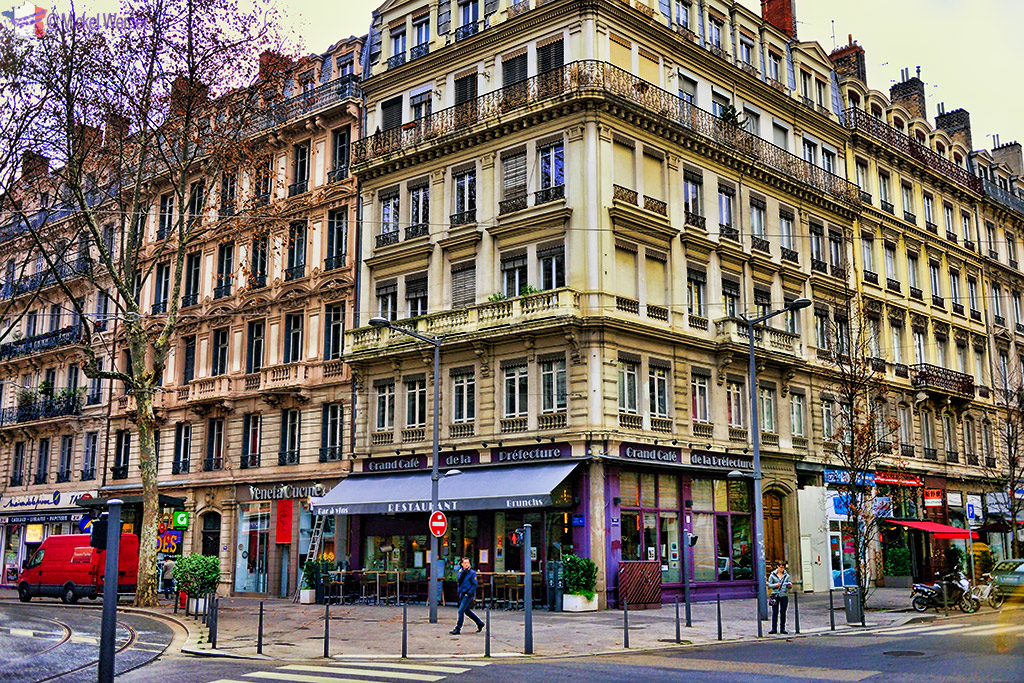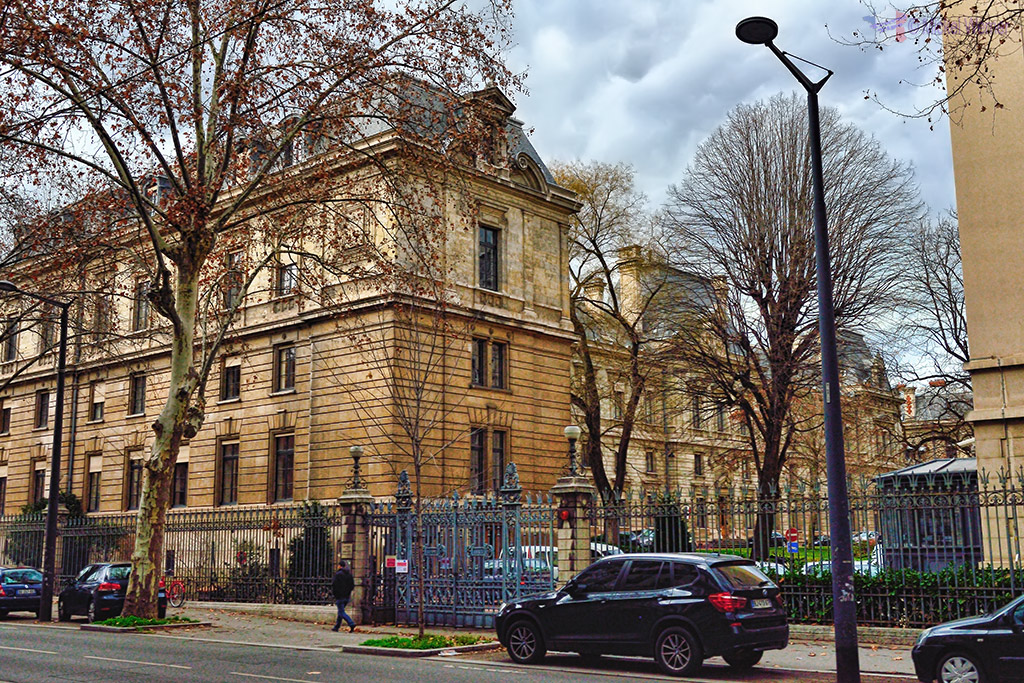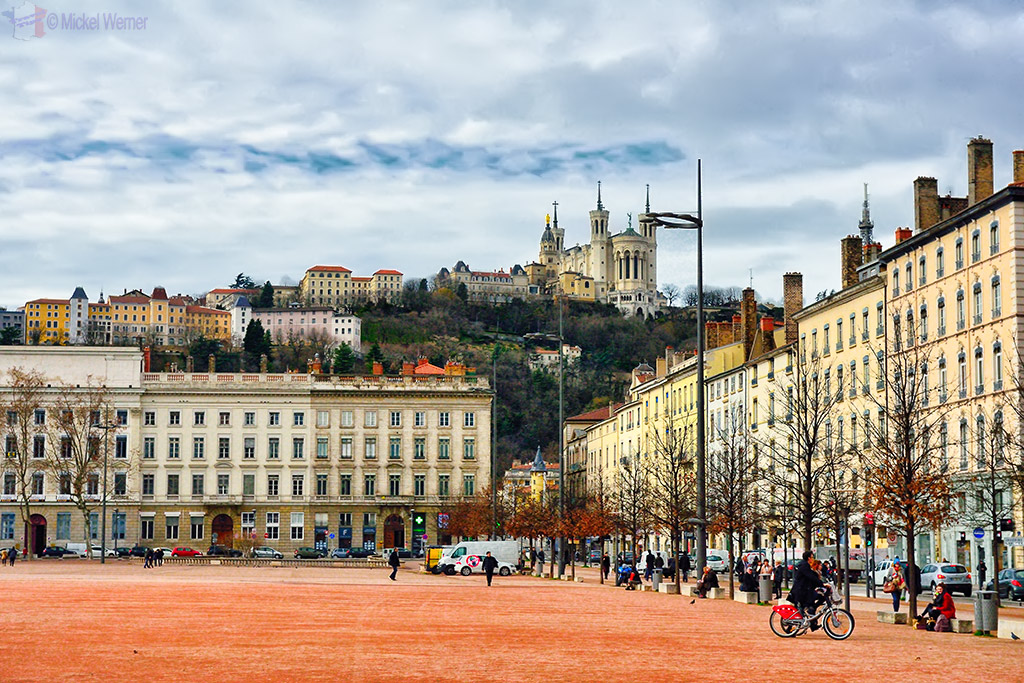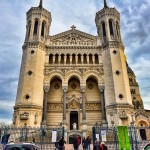Lyon is a city full of contrasts, particularly in its architecture. The city is big, Lyon itself is France’s 3rd largest city, but when you add the suburbs, then the Lyon metropole is France’s 2nd largest metropole (after Paris). It is also the world capital of gastronomy, the city where many of todays top chefs have learned or mastered their profession.
| NOTE: This article was becoming very heavy, with 90 photos, so I split it into 2 parts. Click here for part 2
The panoramic photo above can be clicked on to see a much bigger version of the landscape of Lyon. |
This city/town forms part of one of the French legs of the Santiago de Compostela pilgrimage route.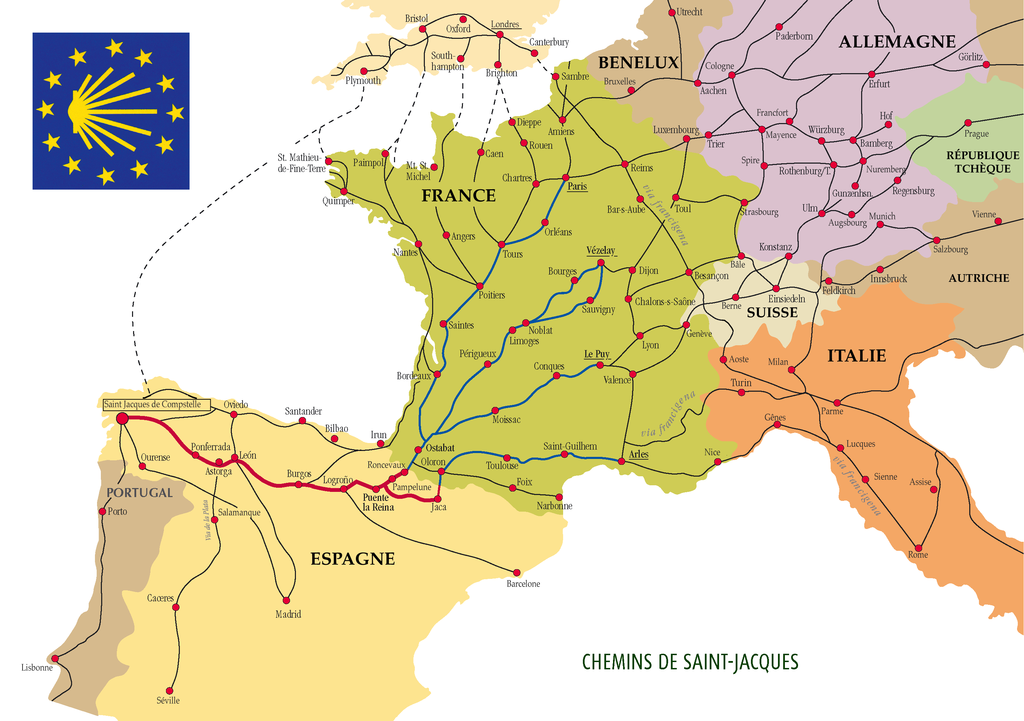
Santiago de Compostela pilgrimage routes
Part-Dieu District
The city was founded by the Romans in the year 43 BC, and there are still many signs that the Romans where there. As for the contrasts, you see them when moving from the city financial centre, the place where the high speed trains (TGV) come, to the outer layer of the city. Flanked by several hills, reminding you a bit of Rome, the centre is flat but then moves up, even quite steep. So you’re in for a walk.
The railway station, one of 6 in Lyon (there is a 7th station at the airport), is mostly dedicated to the high speed trains, the French TGV but also the Italian, Spanish and German equivalents.
As railway stations go, it’s very big since Lyon is at the crossroads between France, Germany, Switzerland, Italy and Spain. Only Paris offers more international destinations, from Lyon you can literally go anywhere (thanks also mainly to an important hub at their airport).
To show the city’s architectural contrasts, let me take you for a walk from the “Part-Dieu” railway station to the top of the main hill. It’s almost a straight line, a distance of 2.5 kilometres.
The first thing you see from the railway station is a major shopping centre called “Le Part Dieu” (as is the name for the whole area, and translated it means “God’s part”).
It’s a very big shopping mall, with over 300 shops and restaurants over three floors.
As shopping centres go, it’s nothing to write home about, except that it’s big but it forms a big part in the life of the people living in Lyon.
The first thing you notice when waking around Lyon is the enormous amounts of bicycle paths. Almost every street has bicycle paths. For the inner portion of the city (i.e. the lower part), bicycles are the norm, but when you get to the hills, it’s a whole different story. Many sidewalks have bicycles paths intertwined, so you need to watch out when walking.
This strange shaped building in the front is a music centre/auditorium, the Auditorium Maurice-Ravel, built in 1975. The big tower behind it is the head office of France’s 2nd largest bank, the Credit Lyonnais.
Les Halles de Lyon Paul Bocuse
Next in line with the walk is one of Lyon’s biggest passions; FOOD.
Inside is an enormous food market where you can buy fresh produce, meats and fish. It is named after the legendary 3-star Michelin chef Paul Bocuse who made his reputation here in Lyon.
But apart from buying produce, many shops offer readymade food.
Walking around the busy aisles is not only a sight for your eyes, but more importantly, a myriad of food smells for your nose. All different sorts of food, ethnic or French are made and sold here. In many places you can sit down and eat while food is being prepared on the spot. It’s quite a gastronomic adventure.
Continuing our walk towards the hills, you’ll stumble upon this enormous modern building:
This is the “new” courts building, built in 1995, and houses all different criminal and even labour courts. Lyon employs some 2200 lawyers.
Furthering our walk, we’ll start seeing less modern buildings and more classical ones, built in the last century.
These are buildings that look more like the Parisian Haussman style buildings. They are four to five stories high and have more imposing facades.
Lyon, like Paris and Marseille, is divided into different “arrondissements“, meaning districts or boroughs. Each arrondissements has its own Mairie (=City Hall) and its elected major, and all are superseded at the top by the overall major of Lyon (more on that later on).
This is the City Hall of the 3rd arrondissements of Lyon. Each district is different, some are big, some are much smaller.
Bourse du Travail
Not too far away from the Mairie is this building:
Although the name of the building is “Bourse du Travail“, meaning “Labour Exchange”, it’s really a theatre. But it started in 1891 as a place where the labour unions got together to plan their actions, but with the uprise of the communist political parties, there was less and less need for these exchanges (you’ll find them in most major cities in France), and slowly it was turned into a theatre.
Outside the theatre is a nice square, including a metro stop, with many trees and playground, and on the outside, several cafes.
Church of the Immaculate Conception
A little further along the way, you’ll stumble upon this church, the church of the Immaculate Conception (“Eglise de l’Immaculée Conception“).
NOTE: Since there are many churches in Lyon, I’ve made a dedicated article on several of them. Click here to read the article “Lyon – Some of the Churches“.
Following the way to the hills, the buildings are getting older and more imposing:
This could be in Paris…. but it’s Lyon.
Prefecture
We then come across a large building complex:
It is the “Prefecture“, the local government of the region (a bit like the governor of the area).
The region administered is the “Auvergne-Rhone-Alpes”region.
After the prefecture we get to our first series (of many) bridges.
Lyon has two major rivers flowing through it, the Rhone and the Saone river. Here we will be using the Wilson bridge. On many parts of both rivers you will find boats moored permanently and often used as restaurants or clubs.
Presqu’ile – The Almost Island
At the other side of the Rhone river is what is called in Lyon the “Presqu’ile“, translated it means the “Almost Island”. That is because it’s not an island but a peninsula. On one side is the Rhone river, on the other side is the Saone river.
At the other side of the Wilson bridge you will see this imposing and immense building:
This was until recently one of the main hospitals of Lyon. But now it is being turned into a 5 star Intercontinental Hotel, a museum and a gastronomic centre. It was called the Hotel Dieu of Lyon and it stopped being used as hospital in 2010.
The first buildings of this hospital were erected in 1184. Above is one of its former entrances.
But the Wilson bridge is not the only bridge in Lyon. Not with two major rivers flowing through the city.
In total there are 34 bridges in Lyon, some of them dedicated to pedestrians, or trains, or just cars. Looking back the way we walked:
You can see the tall towers behind you from the financial & business district (Part-Dieu district).
After crossing the bridge you arrive at the “Place de la Republique” which is a square located halfway the “Rue de la Republique”, a long pedestrian shopping street.
Like anywhere in Lyon, it pays to look up (don’t worry, unlike other cities in France there are no dog piles on the sidewalks). You can see some amazing facades on the buildings, even in a busy shopping street:
La Place Bellecour
A little more towards the West, and you’ll discover one of the biggest squares in Europe, the “La Place Bellecour“. It’s enormous!
As is the case with most cities nowadays, there’s a Ferris Wheel, and Lyon is no exception.
Here is the big square as seen from the adjacent hill (that also has the Basilica church, which is the final destination for this walk). You can see how big the square is.
The square measures 312 m by 200 m (62,000 m² or 15 acres) and no cars are allowed. On the photo above you can see the famous Basilica church on the right.
Here is a closer look:
This square is important for tourists and visitors since it’s the place where the main Tourist Office can be found:
A quick visit here is recommended, and you can buy your public transportation tickets here (which you will need later on when going up the hill). Click here to access the Tourist Office web site.
TIP: For €5.50 you can buy a “Liberte” card that gives you unlimited access for the whole day to all public transportation known to Lyon (metro, trams, trolley bus and funicular). This means you can hop on, hop off at any time, on any of the public transports, anywhere within Lyon. Which is a great idea when you need to climb the hills or criss-cross the city.
Heading towards the end of the peninsula (and yet another set of bridges), you get to see the Basilica church closer and closer:
The hill might not look high, but trust me, it is.
You can see the start of the bridge at the lower centre of the photo above. We’ll be crossing that bridge to enter the old town section of Lyon, also known as “Vieux Lyon”.
The rest of the Lyon Introduction will be on a separate article, since this one has become too long.
Click here to continue reading Part 2 of the Introduction to Lyon.
Related Posts
- 10000
- 10000
- 10000
- 10000
- 10000


















